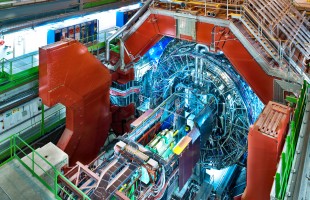Zhanna Khabanova, Phd at Nikhef, will defend her thesis 2 december 2020 online at the Utrecht University.
“Studies of collective effects in pp collisions at the LHC with the balance function for identified particles”
A new state of matter, where quarks and gluons are not confined inside hadrons, is called quark-gluon plasma (QGP). QPG was predicted to exist at sufficiently high temperatures and energy densities by the theory of strong interactions, quantum chromodynamics (QCD), around 50 years ago. At present, this state can be created in the collisions between heavy ions accelerated to ultra-relativistic speeds, which provides a unique possibility to explore the behaviour of strongly interacting matter under extreme conditions.
Experimental measurements at the Relativistic Heavy Ion Collider (RHIC) and the Large Hadron Collider (LHC) allowed to conclude that the medium formed in heavy-ion collisions is strongly coupled and is well described by relativistic viscous hydrodynamic equations for a perfect liquid. These properties lead to the collective expansion of all particles produced in the collision with a common velocity, i.e. collective flow. For some of these measurements proton-proton and proton-nucleus collisions, referred to as small systems, were used as a reference. In these small systems, QGP was not expected to form. Recently, this expectation has been confronted by intriguing results reported by experiments at RHIC and the LHC that indicate the presence of collective flow also in small systems. The origin of this effect is not fully understood. In particular, it is not clear whether this is caused by the QGP formation or by other alternative mechanisms that can lead to similar patterns as hydrodynamic flow without involving the QGP expansion, such as color reconnection.
To investigate this better, the balance function which studies the charge-dependent part of two-particle correlations in the relative pseudorapidity (∆η) and azimuthal angle (∆φ) of the particle pair can be used. In heavy-ion collisions, this measurement has been used as an effective tool to investigate the properties of the QGP evolution such as the hadronization time, the freeze-out conditions and to characterise its collective motion. In this thesis, the analysis of the balance function for identified particles in proton-proton collisions at √s = 5.02 TeV collected by the ALICE experiment is presented. The results are shown for pion, kaon and proton pairs in the low transverse momentum range. In addition, a comparison of the data in proton-proton (pp) and proton-lead (p-Pb) collisions at the same energy is presented. Furthermore, the data in pp are compared with predictions from two different tunes of the PYTHIA8 Monte Carlo model: with and without color reconnection. This mechanism leads to correlations between particles at the microscopic level due to the string recombination. New findings presented in this work show that balance function results for identified hadrons are not in agreement with the expected effect of collective flow in small systems. Moreover, neither of PYTHIA8 tunes is able to reproduce experimental data.
“Studies of collective effects in pp collisions at the LHC with the balance function for identified particles” (pdf)
The thesis defense will take place online and for a limited audience at the Academiegebouw of the Utrecht University.
Promotor: prof. dr. R.J.M. Snellings
Co-promotor: dr. P. Christakoglou
contact: Zhanna Khabanova
More info on the website of the Utrecht University.
